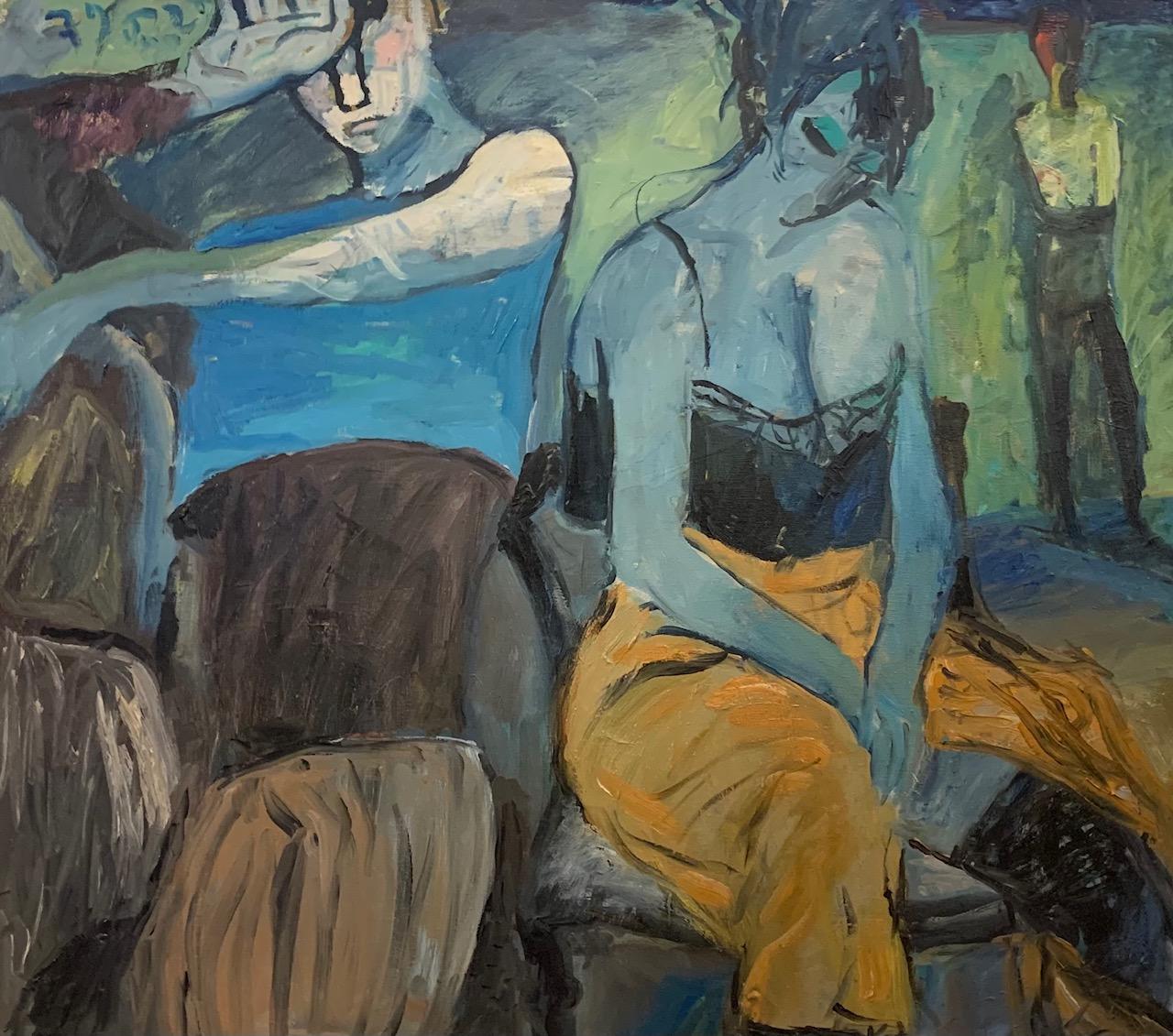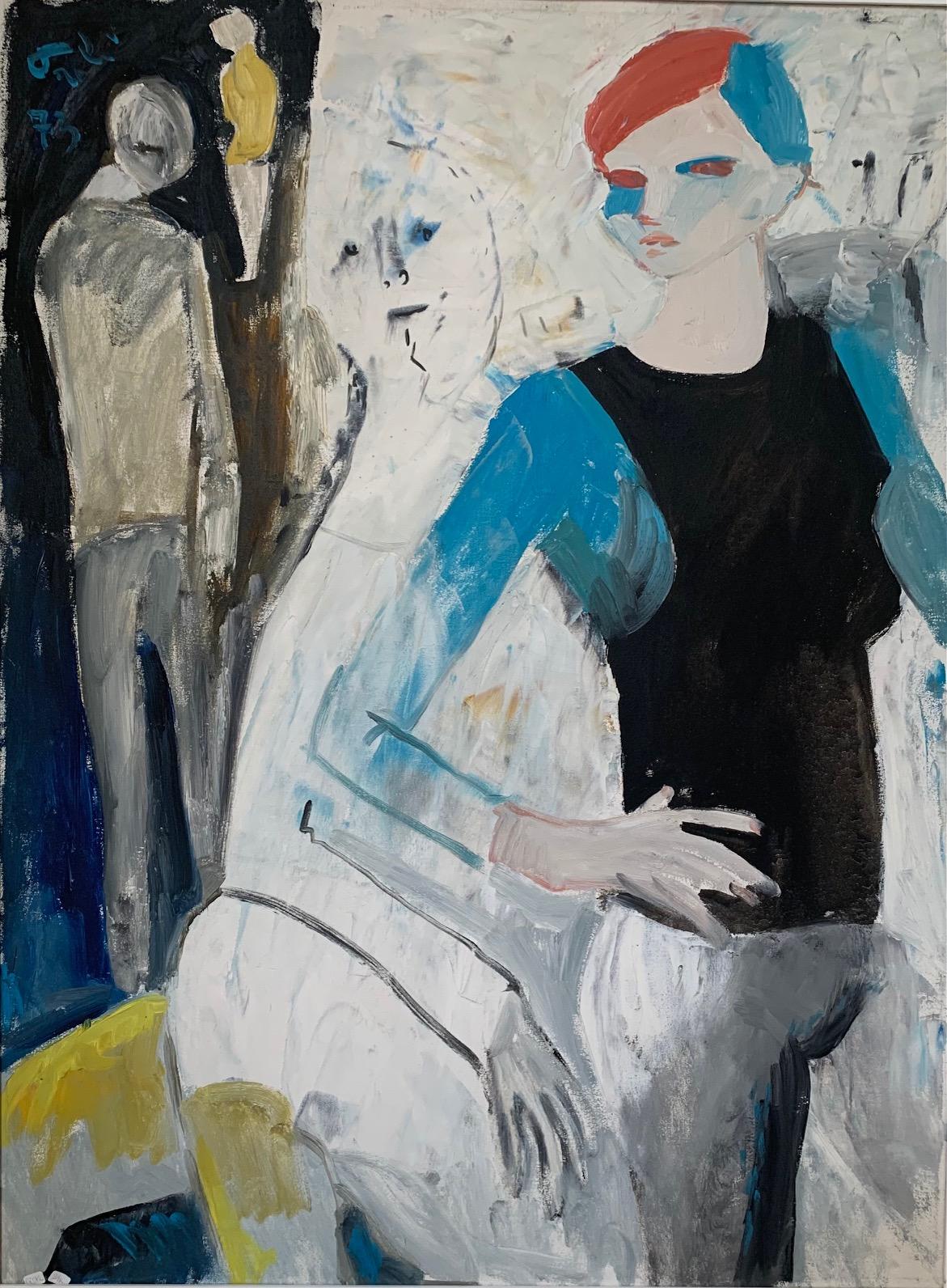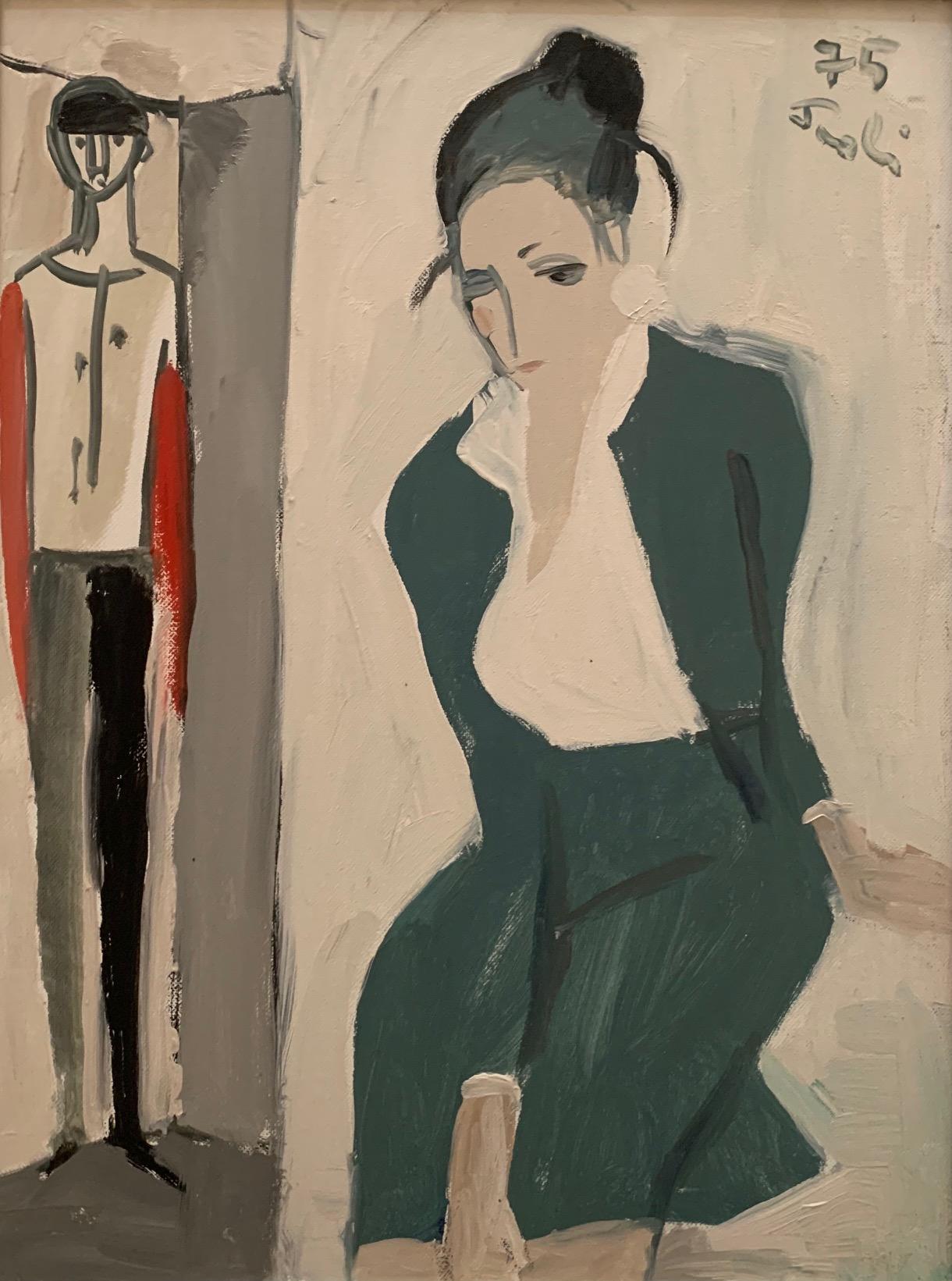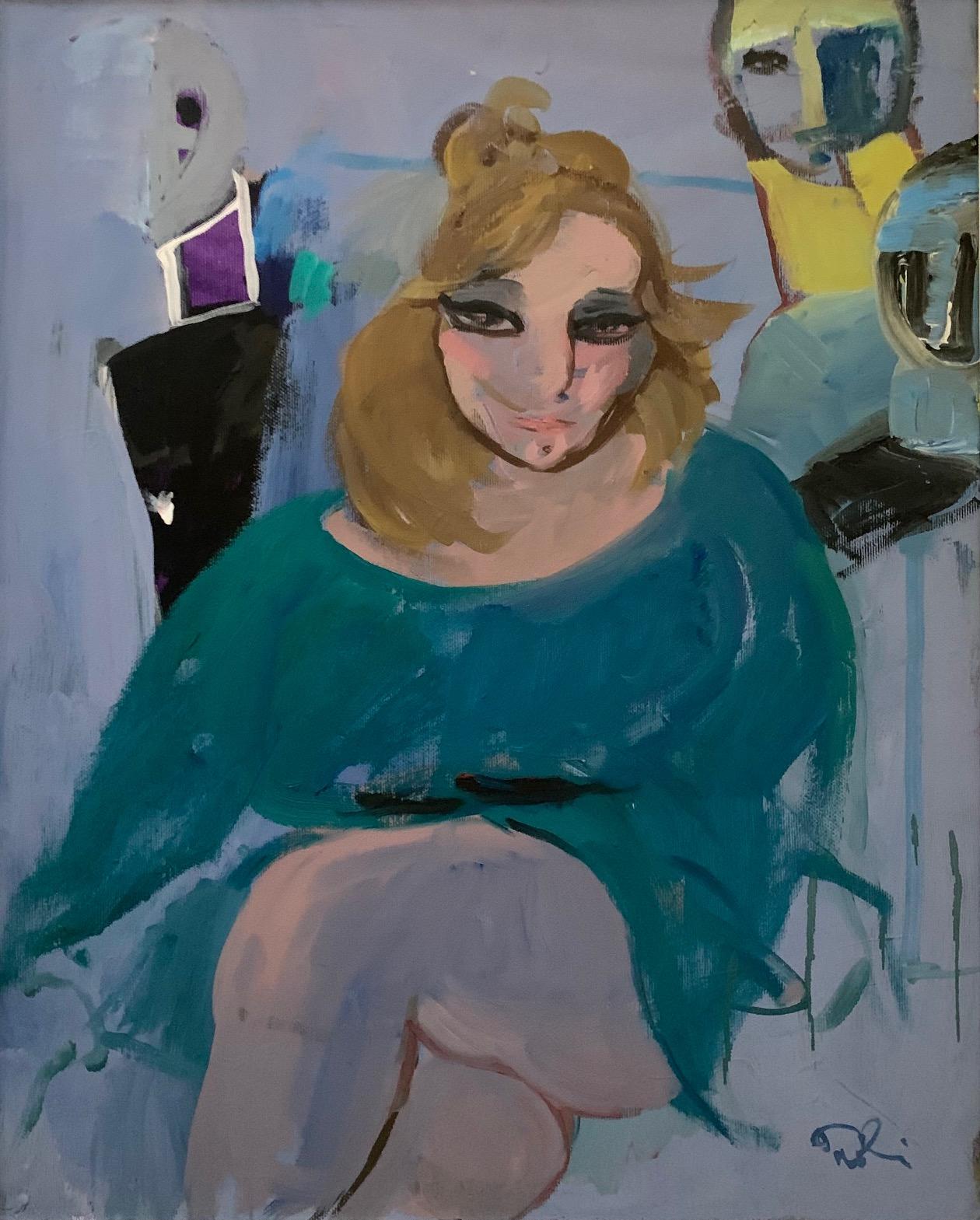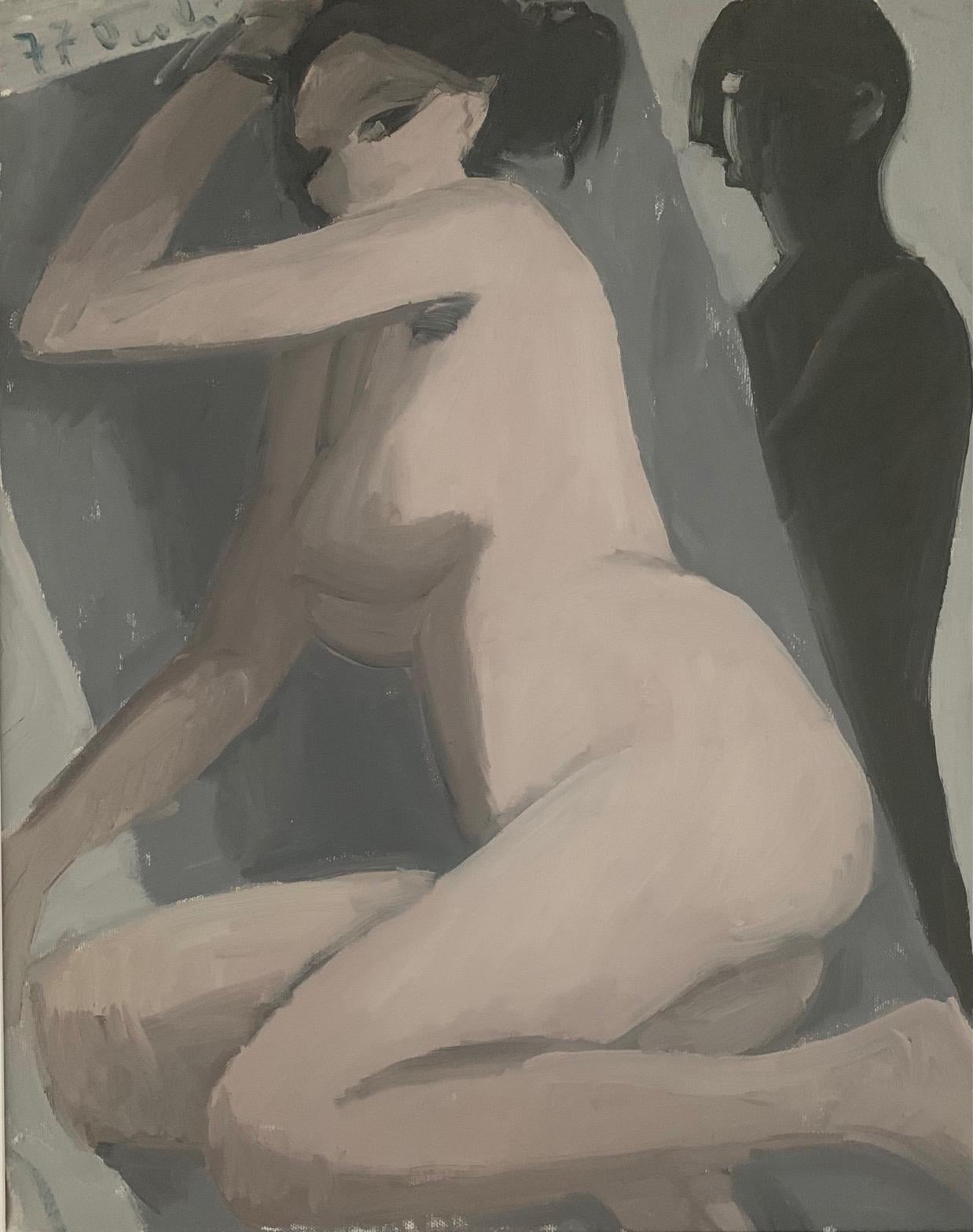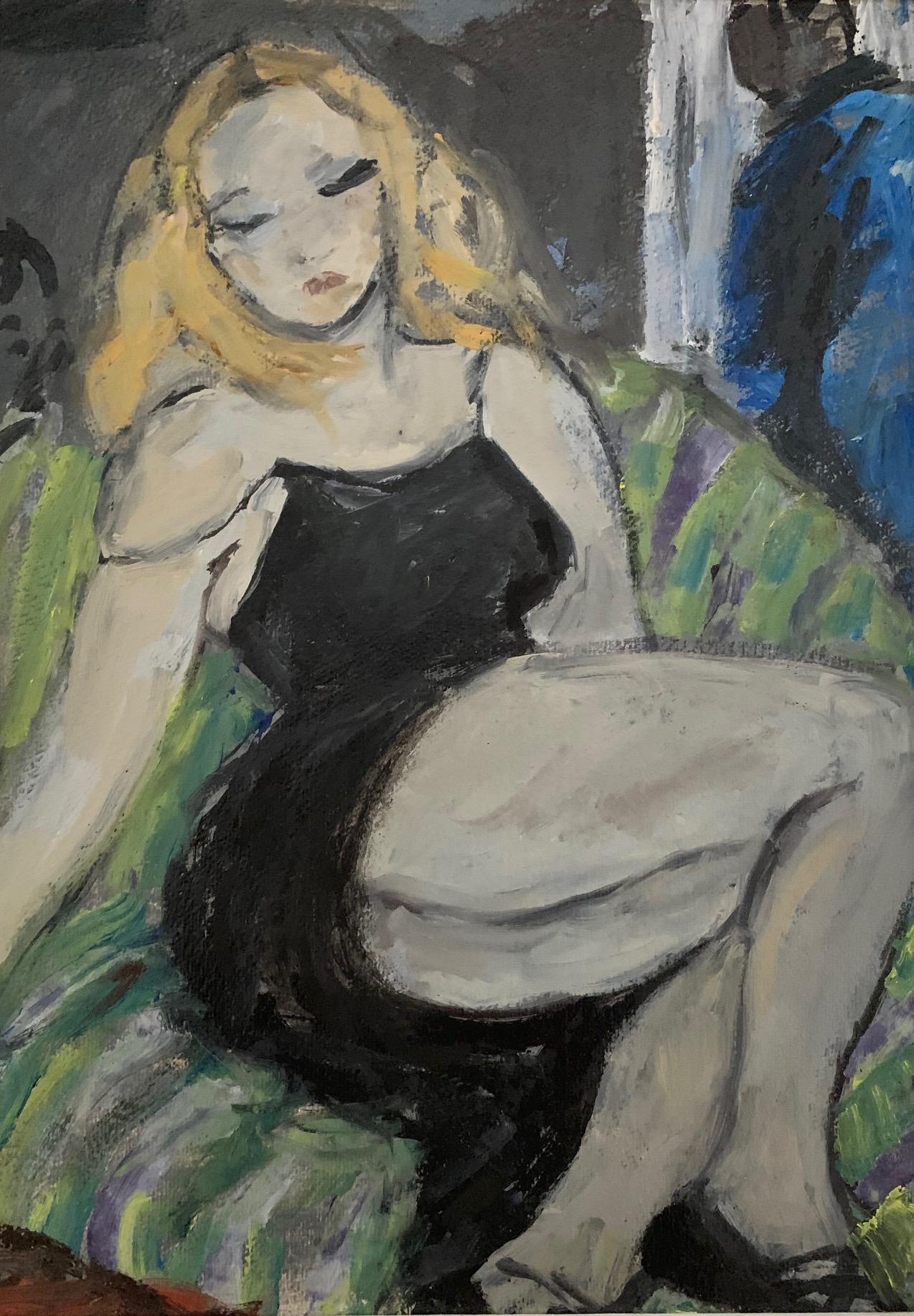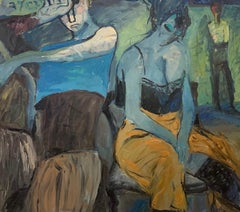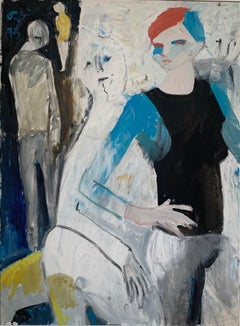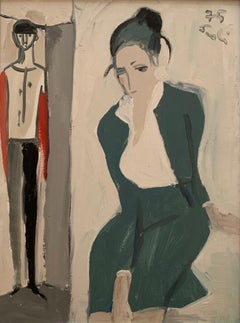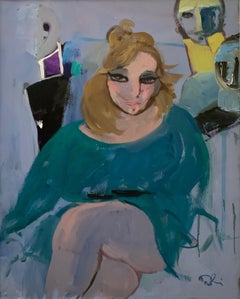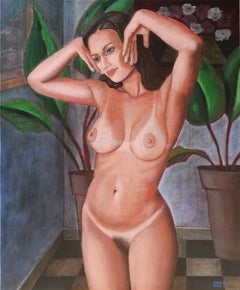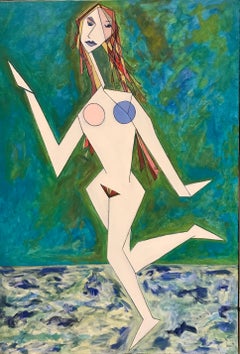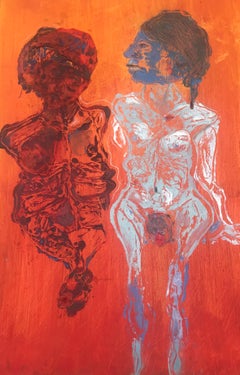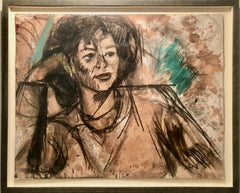Items Similar to Come Una Francesina By Bruno Paoli - Figurative Painting
Want more images or videos?
Request additional images or videos from the seller
1 of 12
Bruno PaoliCome Una Francesina By Bruno Paoli - Figurative Painting
$19,360
$24,20020% Off
£14,778.65
£18,473.3120% Off
€16,989.05
€21,236.3120% Off
CA$27,242.98
CA$34,053.7320% Off
A$30,295.32
A$37,869.1620% Off
CHF 15,911.76
CHF 19,889.7020% Off
MX$370,390.75
MX$462,988.4320% Off
NOK 198,275.79
NOK 247,844.7420% Off
SEK 186,920.52
SEK 233,650.6520% Off
DKK 126,793.22
DKK 158,491.5220% Off
About the Item
Certificate of authenticity and artist catalogue are included.
Bruno Paoli (1915-2005)
Teaching the masters helped create this contemporary master.
Bruno was a professor of art in Florence in the 1950s before gaining recognition in the 60s, leading to the prestigious Mario Bucci award.
In 2001, a retrospective exhibition drew thousands to Arezzo, Italy to soak in his brilliance; early works inspired by the likes of Matisse and Modigliani, later by Gauguin and Toulouse-Lautrec.
Living to 90, Paoli continued painting into his late 80s, devoting his canvases to his favorite subject matter: women.
Keywords: Contemporary Art, Italian artist, figurative, Nude art, cafe, nightlife, Figurative Painting, Contemporary, women, female
- Creator:Bruno Paoli (1915 - 2005, Italian)
- Dimensions:Height: 38 in (96.52 cm)Width: 30 in (76.2 cm)Depth: 2 in (5.08 cm)
- Medium:
- Movement & Style:
- Period:
- Condition:
- Gallery Location:Carmel, CA
- Reference Number:Seller: "We cater equally to the novice and the collector, 1stDibs: LU1751213997932
About the Seller
5.0
Gold Seller
Premium sellers maintaining a 4.3+ rating and 24-hour response times
Established in 1997
1stDibs seller since 2022
55 sales on 1stDibs
Typical response time: 3 hours
- ShippingRetrieving quote...Shipping from: Carmel, CA
- Return Policy
Authenticity Guarantee
In the unlikely event there’s an issue with an item’s authenticity, contact us within 1 year for a full refund. DetailsMoney-Back Guarantee
If your item is not as described, is damaged in transit, or does not arrive, contact us within 7 days for a full refund. Details24-Hour Cancellation
You have a 24-hour grace period in which to reconsider your purchase, with no questions asked.Vetted Professional Sellers
Our world-class sellers must adhere to strict standards for service and quality, maintaining the integrity of our listings.Price-Match Guarantee
If you find that a seller listed the same item for a lower price elsewhere, we’ll match it.Trusted Global Delivery
Our best-in-class carrier network provides specialized shipping options worldwide, including custom delivery.More From This Seller
View AllEva By Bruno Paoli - Figurative Painting
Located in Carmel, CA
Certificate of authenticity and artist catalogue are included.
Bruno Paoli (1915-2005)
Teaching the masters helped create this contemporary master.
Bruno was a professor of art in F...
Category
1990s Contemporary Figurative Paintings
Materials
Canvas, Oil
Moment By Bruno Paoli - Figurative Painting
Located in Carmel, CA
Certificate of authenticity and artist catalogue are included.
Bruno Paoli (1915-2005)
Teaching the masters helped create this contemporary master.
Bruno was a professor of art in F...
Category
2010s Contemporary Figurative Paintings
Materials
Canvas, Oil
Immagini By Bruno Paoli - Figurative Painting
Located in Carmel, CA
Certificate of authenticity and artist catalogue are included.
Bruno Paoli (1915-2005)
Teaching the masters helped create this contemporary master.
Bruno was a professor of art in F...
Category
2010s Contemporary Figurative Paintings
Materials
Canvas, Oil
Silvana By Bruno Paoli - Figurative Painting
Located in Carmel, CA
Certificate of authenticity and artist catalogue are included.
Bruno Paoli (1915-2005)
Teaching the masters helped create this contemporary master.
Bruno was a professor of art in F...
Category
2010s Contemporary Figurative Paintings
Materials
Canvas, Oil
$16,160 Sale Price
20% Off
Rossana By Bruno Paoli - Figurative Painting
Located in Carmel, CA
Certificate of authenticity and artist catalogue are included.
Bruno Paoli (1915-2005)
Teaching the masters helped create this contemporary master.
Bruno was a professor of art in F...
Category
2010s Contemporary Figurative Paintings
Materials
Canvas, Oil
$17,520 Sale Price
20% Off
Tensions By Bruno Paoli - Figurative Painting
Located in Carmel, CA
Certificate of authenticity and artist catalogue are included.
Bruno Paoli (1915-2005)
Teaching the masters helped create this contemporary master.
Bruno was a professor of art in F...
Category
2010s Contemporary Figurative Paintings
Materials
Oil, Board
You May Also Like
Italian Contemporary Art by Andrea Vandoni - Tan 2020 No.3
By Andrea Vandoni
Located in Paris, IDF
Oil on canvas
Andrea Vandoni is an Italian artist born in 1972 who lives and works in Novara, Italy. The artist studied and trained at the School of the Archaeologists and the Scho...
Category
2010s Contemporary Figurative Paintings
Materials
Oil, Canvas
French Contemporary Art by Abraham Dayan - La Venus
By Abraham Dayan
Located in Paris, IDF
Signed on bottom right front
Born in 1960 in Casablanca, Morocco
Lives & works in Bourg-en-Bresse, France
Bold strokes, rich textures and a brave use of color are hallmarks of this young Frenchman, Abraham Dayan...
Category
2010s Contemporary Figurative Paintings
Materials
Oil, Canvas
Italian Contemporary Art by Federica Frati - Lovers
Located in Paris, IDF
Monotype & collage on paper
Federica Frati is an Italian artist born in 1977 who lives lives and works in Brecia, Italy. She is graduated from art school Foppa where she learned the...
Category
2010s Contemporary Figurative Paintings
Materials
Monotype, Paper
Portrait Of A Young Model Work On Paper
By Alexander Rutsch
Located in Lake Worth Beach, FL
Portrait Of A Young Model Work On Paper
Rutsch is always "scribbling and scrabbling." He is an artist of the purest breed—an artist who has no choice but to paint. He is a chosen traveler of the depths of existence; a man who follows a longing to explore his inner self and relate his findings with the energy and identity of the universe.
The celebrated Austrian artist approaches painting and sculpture as he lives life—with the eyes of a child and the hand of a poet. Constantly in the quest for rhythms of form and vibrations of color, he catches those "sparks in the shadow" and evidences their fullest reality and beauty in his creations.
Each of his paintings is a careful construction as it is a spontaneous act of love. While he might attribute certain artistic expressions to "coincidence," his inspiration comes from such diverse sources as: memories, dreams, sounds, numbers, telephone poles and drift wood. Rutsch has an affinity to vibrant colors, strong contours and rich brush strokes which are apparent in his oils, mixed media works and ink drawings. He has a sensitivity to the unusual, the discarded and a fondness for the ugly as well as the chaotic. These, he often transforms into poignant welded steel abstractions.
Rutsch has an aversion to politics, citing dates and expounding upon honors achieved. There is no talk about 'profound symbolism' in his work and as Carlo McCormick writes in the introduction to Rutsch's monograph, "Meaning is not a seed that Rutsch plants, nurtures and then harvests. It is what grows wild in a volcanic swamp of fossilized, decaying and new-born fancies—as an afterthought and aftershock." Alexander Rutsch is not concerned with interpretations; he is, however, passionate about the process of making art and surrenders his entire being as an instrument to the act of creation.
The geometry of his imagination overflows with figures, profiles and penetrating strong eyes—windows to a deeper place. Their vitality and sensuality pulsate through the "dreamscapes" of Rutsch's created worlds. At times romantic, yet always wild with energy, human forms and experiences are essential to the artist's vocabulary.
The son of opera singers and a singer himself, Rutsch speaks of "the art of painting as the art of silence" and the job of the painter "to dedicate himself to the silence." He adds though, "that this silence is the greatest existing sound in the universe." One wonders why then, if painting is "the art of silence," that Rutsch's paintings scream with sound. Sometimes melancholy, sometimes sensual, sometimes dissonant and sometimes whispering, the rhythms are always rich in the celebration of life and our shared humanity.
Painter, sculptor and poet, Rutsch's oeuvre over the past four decades is tremendous. Celebrated and collected especially in Vienna, Paris, Brussels and New York, he studied with renowned teachers like Boeckl and Dorowsky and collaborated with such geniuses as Salvador Dali. Having left Vienna in the fifties, Rutsch moved to Paris and took the city's art scene by storm. There, Picasso was so enthralled with a portrait Rutsch has done of him that, in a state of great excitement, he countersigned it.
Biography
Alexander Rutsch was born in Russia in 1916 but raised in Belgrade, Yugoslavia. After studying voice in Austria he became an opera singer like his parents, but after WWII, Rutsch's love for visual expression propelled him to change careers. He was a painter, sculptor, philosopher, musician, singer and poet. His life as a romantic is reflected in his work, as he sought to perfect his soul and humanity, "I paint my dreams," said Rutsch.
"My dreams are color and life. They soar in my head like millions of symphonies. I can never stop building dreams."
In 1952, after studying under Josef Dobrowsky, Josef Hoffmann and Herbert Boeckl at the Vienna Academy of Fine Arts, Alexander Rutsch received a scholarship to study in France. There he made contacts and began collaborations with his contemporaries, Picasso and Dali. Rutsch said of his experiences with Picasso, "Picasso played a short but important moment in my life in Paris that affected my entire artistic future. I learned from him that it is not important if art is not aesthetically finished. It can be raw, uncooked, rough. If an artist feels he has said it—it is not important to polish or finish it. Because of Picasso, I learned that if I don't feel the need to finish—I don't have to." In 1954 he exhibited his work at the Salon Artistique International de Saceux and won first prize for abstract painting, the first of may awards received during his prolific career.
During the 13 years he lived in Paris, Rutsch exhibited in many prominent galleries there and throughout Europe. In 1958, The City of Paris awarded him the prestigious Arts, Science and Letters Silver Medal. In 1966, Jean Desvilles presented his prize winning film "Le Monde de Rutsch" at the Cannes Film Festival and the Venice Biennial. In 1968 Rutsch moved to Pelham, New York where he continued to work in his studio and exhibit in galleries and museums worldwide.
Rutsch's work, as seen through his mastery of many art forms—sculpture, painting, print-making, and drawing, and a wide variety of other media has been described as "vibrating showers of lines, bold geometries, wounded anatomically rambling scrap-wood skeletons...
Category
1980s Expressionist Portrait Paintings
Materials
Watercolor, Charcoal, Oil Pastel
Figura Femminile IV, 2018
Located in Atlanta, GA
Son of painter Angelo Bonfanti, Maurizio Bonfanti attended Bergamo's Liceo Artistico and studied etching at the Accademia di Belle Arti in the same city. Though he enrolled to study ...
Category
21st Century and Contemporary Modern Figurative Paintings
Materials
Mixed Media
Young Woman Portrait Mixed Media On Paper
By Alexander Rutsch
Located in Lake Worth Beach, FL
Young Model Expressionist Portrait
Rutsch is always "scribbling and scrabbling." He is an artist of the purest breed—an artist who has no choice but to paint. He is a chosen traveler of the depths of existence; a man who follows a longing to explore his inner self and relate his findings with the energy and identity of the universe.
The celebrated Austrian artist approaches painting and sculpture as he lives life—with the eyes of a child and the hand of a poet. Constantly in the quest for rhythms of form and vibrations of color, he catches those "sparks in the shadow" and evidences their fullest reality and beauty in his creations.
Each of his paintings is a careful construction as it is a spontaneous act of love. While he might attribute certain artistic expressions to "coincidence," his inspiration comes from such diverse sources as: memories, dreams, sounds, numbers, telephone poles and drift wood. Rutsch has an affinity to vibrant colors, strong contours and rich brush strokes which are apparent in his oils, mixed media works and ink drawings. He has a sensitivity to the unusual, the discarded and a fondness for the ugly as well as the chaotic. These, he often transforms into poignant welded steel abstractions.
Rutsch has an aversion to politics, citing dates and expounding upon honors achieved. There is no talk about 'profound symbolism' in his work and as Carlo McCormick writes in the introduction to Rutsch's monograph, "Meaning is not a seed that Rutsch plants, nurtures and then harvests. It is what grows wild in a volcanic swamp of fossilized, decaying and new-born fancies—as an afterthought and aftershock." Alexander Rutsch is not concerned with interpretations; he is, however, passionate about the process of making art and surrenders his entire being as an instrument to the act of creation.
The geometry of his imagination overflows with figures, profiles and penetrating strong eyes—windows to a deeper place. Their vitality and sensuality pulsate through the "dreamscapes" of Rutsch's created worlds. At times romantic, yet always wild with energy, human forms and experiences are essential to the artist's vocabulary.
The son of opera singers and a singer himself, Rutsch speaks of "the art of painting as the art of silence" and the job of the painter "to dedicate himself to the silence." He adds though, "that this silence is the greatest existing sound in the universe." One wonders why then, if painting is "the art of silence," that Rutsch's paintings scream with sound. Sometimes melancholy, sometimes sensual, sometimes dissonant and sometimes whispering, the rhythms are always rich in the celebration of life and our shared humanity.
Painter, sculptor and poet, Rutsch's oeuvre over the past four decades is tremendous. Celebrated and collected especially in Vienna, Paris, Brussels and New York, he studied with renowned teachers like Boeckl and Dorowsky and collaborated with such geniuses as Salvador Dali. Having left Vienna in the fifties, Rutsch moved to Paris and took the city's art scene by storm. There, Picasso was so enthralled with a portrait Rutsch has done of him that, in a state of great excitement, he countersigned it.
Biography
Alexander Rutsch was born in Russia in 1916 but raised in Belgrade, Yugoslavia. After studying voice in Austria he became an opera singer like his parents, but after WWII, Rutsch's love for visual expression propelled him to change careers. He was a painter, sculptor, philosopher, musician, singer and poet. His life as a romantic is reflected in his work, as he sought to perfect his soul and humanity, "I paint my dreams," said Rutsch.
"My dreams are color and life. They soar in my head like millions of symphonies. I can never stop building dreams."
In 1952, after studying under Josef Dobrowsky, Josef Hoffmann and Herbert Boeckl at the Vienna Academy of Fine Arts, Alexander Rutsch received a scholarship to study in France. There he made contacts and began collaborations with his contemporaries, Picasso and Dali. Rutsch said of his experiences with Picasso, "Picasso played a short but important moment in my life in Paris that affected my entire artistic future. I learned from him that it is not important if art is not aesthetically finished. It can be raw, uncooked, rough. If an artist feels he has said it—it is not important to polish or finish it. Because of Picasso, I learned that if I don't feel the need to finish—I don't have to." In 1954 he exhibited his work at the Salon Artistique International de Saceux and won first prize for abstract painting, the first of may awards received during his prolific career.
During the 13 years he lived in Paris, Rutsch exhibited in many prominent galleries there and throughout Europe. In 1958, The City of Paris awarded him the prestigious Arts, Science and Letters Silver Medal. In 1966, Jean Desvilles presented his prize winning film "Le Monde de Rutsch" at the Cannes Film Festival and the Venice Biennial. In 1968 Rutsch moved to Pelham, New York where he continued to work in his studio and exhibit in galleries and museums worldwide.
Rutsch's work, as seen through his mastery of many art forms—sculpture, painting, print-making, and drawing, and a wide variety of other media has been described as "vibrating showers of lines, bold geometries, wounded anatomically rambling scrap-wood skeletons...
Category
1980s Expressionist Portrait Paintings
Materials
Charcoal, Oil Pastel, Watercolor, Archival Paper
More Ways To Browse
Seville Art
Native American Bear
Old Master Oil On Wood Panel
Rowing Art
Seventeenth Century Paintings
Bali Painting
Orchestra Paintings
Ugly Painting
Young Girl Oil Painting 20th Century
Gun Oil Paintings
Indian Dance Painting
Michael Challenger
Oil Paintings Of Swimmers
Opera Box
20th C Russian Paintings
Disney Background
Russian Orthodox
Skull Paintings
